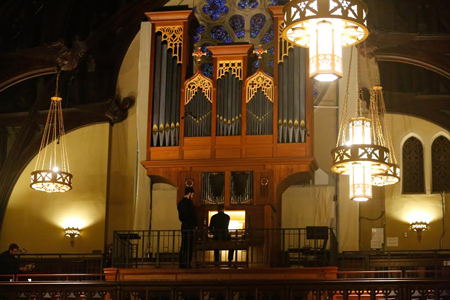by Daniel Hathaway

Liebman, who last appeared on the Tri-C series four years ago, chose a big program that culminated in all four of Chopin’s Ballades, a grouping the pianist said in an interview with this publication had been a longtime programming dream.
An elegant player clad in a long, silver lamé gown, Liebman brought poetry and charm to the four works, which, bearing opus numbers 23, 38, 47, and 52, are spread evenly across the composer’s oeuvre. Her sensitive touch coaxed both attractive fortes and lyrical soft passages out of the borrowed Steinway.
Liebman began her program with Beethoven’s Sonata No. 31 in A-flat, playing as if she already knew what surprises the composer had lurking around the next corner.
Beautiful voicings distinguished her interpretation of three selections from Debussy’s Images, Book 1 (Reflets dans l’eau, Hommage à Rameau, Mouvement), and she ended the first half of her recital with a vivid account of Prokofiev’s brief Sonata No. 3, ably handling its many changes of mood and style.

Jonathan Moyer used both instruments to fine effect, beginning in the back with Johann Heinrich Buttstett’s witty Praeludium und Fuga, whose rests (as the saying goes) are as important as its notes. Giles Farnaby’s Loth to Depart variations and two anonymous chorales from the Lüneburg Organ Tablature gave Moyer abundant opportunities to show off the colors of the spunky little freestanding instrument.
In between, a leisurely, expressive account of J.S. Bach’s BWV 662 Allein Gott made nice use of a buzzy reed stop as well as the slow undulations of the full organ tremulant.
The last word from the back gallery came from Buxtehude — perhaps the least-known of his three g-minor Praeludia, BuxWV 148. Moyer played up the rhetorical qualities of the work — its chromaticism, jolly repeated-note fugue, and final, imposing pedal ostinato — ending with a bracing tutti that filled the nave.
Moving to the other end of the church amid congratulatory speeches from his Covenant colleagues, Moyer brought mysterious colors to Olivier Messiaen’s “Institution de l’Eucharistie” from Livre du Saint Sacrement, then ended his program with one of his own sabbatical projects: the premiere of his Three Pieces for Organ.
The new trilogy (Fantasie, Merry Fugue, and Passacaglia) is the product of someone who knows both the instrument and its literature from the inside out. The piece adds importantly to the canon while respecting its historical lineage — which in this case leans toward the French Romantic.
The Fantasie is conceived on a wide-ranging palette with abundant dissonance and virtuosic gestures. The Fugue is indeed merry if not downright cheeky, its humorous, wide intervals played on high-pitched stops. The 21 ingenious variations of the Passacaglia top Bach’s work by one, but the length of the movement in performance suggests that some editing might be in order. Moyer launched his new work with a brilliant performance.
Published on ClevelandClassical.com October 29, 2019.
Click here for a printable copy of this article


